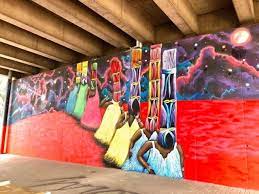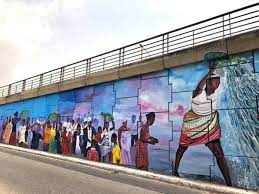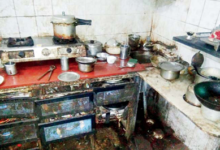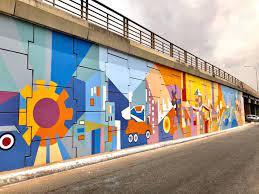
Over the years, the expression “taking to the streets” has been used to depict an arena where people bring things into public awareness.
Street art is one of such activities where people or artists take to the streets to channel out their messages to the general public.
It is a form of art created on surfaces in public places like exterior building walls, highway overpasses, and sidewalks.
However, many people do not recognise this artwork as art and sometimes relate this art with vandalism.
With its linkage to graffiti, street art tends to happen in urban areas, and is usually created as a means to convey a message connected to political ideas or social commentaries.
It is often driven by a preference on the part of the artist to communicate directly with the public at large, free from perceived limits of the formal art world.
The central force behind street art grew out of the belief that art should be reachable, rather than concealed in galleries and be democratic and all-inclusive for everyone to create art and have it seen by others.
While some street artists create sculptures, others are known for the use of unconventional art methods such as spray paint, stencils, wheat paste posters, and stickers.
Street Art has also been called independent public art, post-graffiti, and guerrilla art.
BACKGROUND OF STREET ART IN GHANA
According to the National Organiser of the Ghana Visual Arts Association (GAVA), Aubrey-Seth Attoh, the emergence of street art in the country can be traced to the outset of Murals in the country.
Murals were long-existent and served as a valued testament of life from primitive days to now. From the cave paintings at Lascaux Grottoes in southern France to the street art murals of today, people leave signs of their own existence in many places around the world.
Mr Attoh who was speaking in an interview with the Ghanaian Times in Accra said murals held great significance for mankind, as they depicted life activities, everyday scenery and usually religious traditions of the time they were created in, giving us a priceless look of the diversity of our cultures during different periods.
Over the course of time, he noted that murals covered the interiors and exteriors of many public buildings, all the while keeping their initial meaning and purpose: to paint a picture of society, created from stories, values, dreams, change.
Mr Attoh noted that after the country gained independence in the late 1950s, Dr Kwame Nkrumah wanted to propagate a national and African identity. Hence, he said murals were used to communicate the “Africaness” or Ghanaian culture.
In doing so, the government was said to have identified and contracted a number of artists to do specific arts. These state contract works given to the artists allowed them to showcase their arts in a variety of ways.
Artists contracted included Madam Theodosia Okoh who designed the national flag; Kofi Antubam who pioneered the use of Adinkra symbols in Ghanaian arts and designed the presidential mace and seat for Dr Kwame Nkrumah; Nii Amon Kotei, the celebrated designer of the coat of arms of Ghana; Ablade Glover, Atta Kumi, and Oku Ampofo among others.
Their realistic stories of fanciful African life, shown in wall paintings and mosaics added to the national pride and development and represented Ghana in a way that depicted a modern nation with a unique past and culture.
Along the line, graffiti was then said to haveemerged in the country around the 20th century and involved a behaviour performed in order to gain attention or as a form of thrill seeking.
It was also understood as an expressive art form as during the World War II, it became popular for soldiers to write phrases like “I was here some,” along with a simple sketch of a bald figure with a large nose peeking over a ledge, on surfaces along their paths.
The intention was to create an idea of identity for these soldiers during their difficult times, and to make themselves known.
The Chale Wote Street Art Festival then began in 2011. Also known as ‘Chale Wote,’ the festival brought art, music, dance and performance out into the streets of James Town in Accra and targeted exchanges between local and international artists and patrons by creating and appreciating art together.
Since 2011, Chale Wote has exhibited street paintings, graffiti murals, photography, theatre, spoken word,live street performances, film shows, fashion parade among several art forms held annually at the historical James town of Accra.
Through Chale Wote, street art sprang up in the country and now artists in Accra are transforming the dull walls and spaces of the city into vibrant Ghana street art depicting the country’s rich culture and bold colours.
AKO ADJEI INTERCHANGE–MURAL PROJECT
As part of government’s efforts to beautify the country’s capital city, Accra, the Ghana Association of Visual Artists (GAVA) and AccraDotAlt through the “Accra Beautification Project”used streets arts to create beauty (aesthetics).
Initiated by the GAVA, in partnership with the Accra Metropolitan Assembly and the Korle Klottey Municipal Assembly, the artwork depicted Ghanaian culture, tradition, religion, and festivals.
Mr Attoh said the artwork was to promote the Sustainable Development Goals (SDGs) and project Accra as the “Gate”, “The Industrial Hub” and “The Indigene Hub” of Ghana.
He noted that about 30 artists undertook that project.
ARTWORK ON THE NSAWAM ROAD- “The Beauty of Africa”
Mr Quarshie Atsu Tormi is an artist who has a painting on a bridge on the Nsawam road with the title- “The Beauty of Africa”.
He painted a lady with a scarf of different colors with the inspiration that the country needed to portray its beauty colours and African culture.
His message was to remind Ghanaians of the country’s rich culture which was needed to be protected and not destroyed.
BY ABIGAIL ARTHUR





